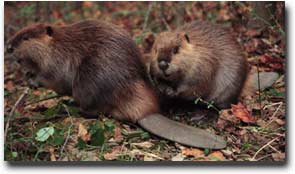 Beaver Biology: The beaver is the largest rodent found in North America. Adult beavers can weigh 65+ pounds and measure up to four feet, with an additional tail length of 12″ to 18″. They have webbed hind feet, waterproof fur, and paddle-shaped tails.The beaver is well-suited to living in a watery environment. Beaver incisors (front teeth) grow for their entire life. In order to keep their teeth at a manageable size, they constantly chew on vegetation. Beaver are a major nuisance species in many parts of the country.
Beaver Biology: The beaver is the largest rodent found in North America. Adult beavers can weigh 65+ pounds and measure up to four feet, with an additional tail length of 12″ to 18″. They have webbed hind feet, waterproof fur, and paddle-shaped tails.The beaver is well-suited to living in a watery environment. Beaver incisors (front teeth) grow for their entire life. In order to keep their teeth at a manageable size, they constantly chew on vegetation. Beaver are a major nuisance species in many parts of the country.
Beaver Nuisance Concerns
Beavers are considered a nuisance for two primary reasons:
- Tree cutting is undesirable to landowners who want to protect their trees.
- Dam building is the other, more serious matter, and can result in flooding forests, farm land, plugged drainage culverts and the washout of roads.
Beavers do not respond to repellents, and they are impossible to exclude. They may abandon a dam site that is continually destroyed, but the most effective means of beaver control is trapping.
Read the following excerpt from the Indiana DNR website regarding Beavers:
MANAGEMENT AND CONTROL
Due to their small size, lack of rich color, fur coarseness and heavy hide, Indiana beaver lack the qualities sought by the fur industry. Only a small portion of the state harvest is actually used by furriers. About 30 to 40 percent are used to make partially-furred garments such as pieced coats, hats and gloves, and less than 10 percent are used to make high fashion apparel. As a result, demand for Indiana beaver has been quite low and average pelt price has seldom exceeded $10. Low prices combined with the amount of time required to properly skin, flesh and stretch the hide produce very little incentive for trappers to trap beaver.
Although beaver harvest has steadily increased, it is not indicative of the economic demand placed upon the resource. Instead, it is in response to the beaver’s increasing availability and attempts by landowners to remove nuisance beaver during the legal season. At present, the owner or tenant of any property may take without permit during the closed season, any beaver discovered in the act of damaging such property.
A beaver dam is not the location where a beaver lives. It is simply a mass of woody debris that may be able to be removed without a permit from the DNR, depending on its location and the equipment to be used. An outline of permit requirements is at: http://www.in.gov/dnr/water/files/wa-Logjam_Removal_Guide.pdf. Be sure to obtain permission from the property owner(s) if the dam is on property other than your own.
How to get rid of beaver
Check with your state’s DNR if you want to remove a beaver on your own property. In Indiana, for instance, it is legal for a landowner to remove a beaver from their own property without license if said animal is seen causing damage.
It is highly recommended by WCON that you find a reputable Nuisance Wildlife Company near you to remove any unwanted animals. Nuisance Wildlife Companies will have any necessary permits as well as the experience to safely and humanely remove beaver, and the damage they have caused.
Some states allow for the shooting of beaver, where others require the trapping of the animal.